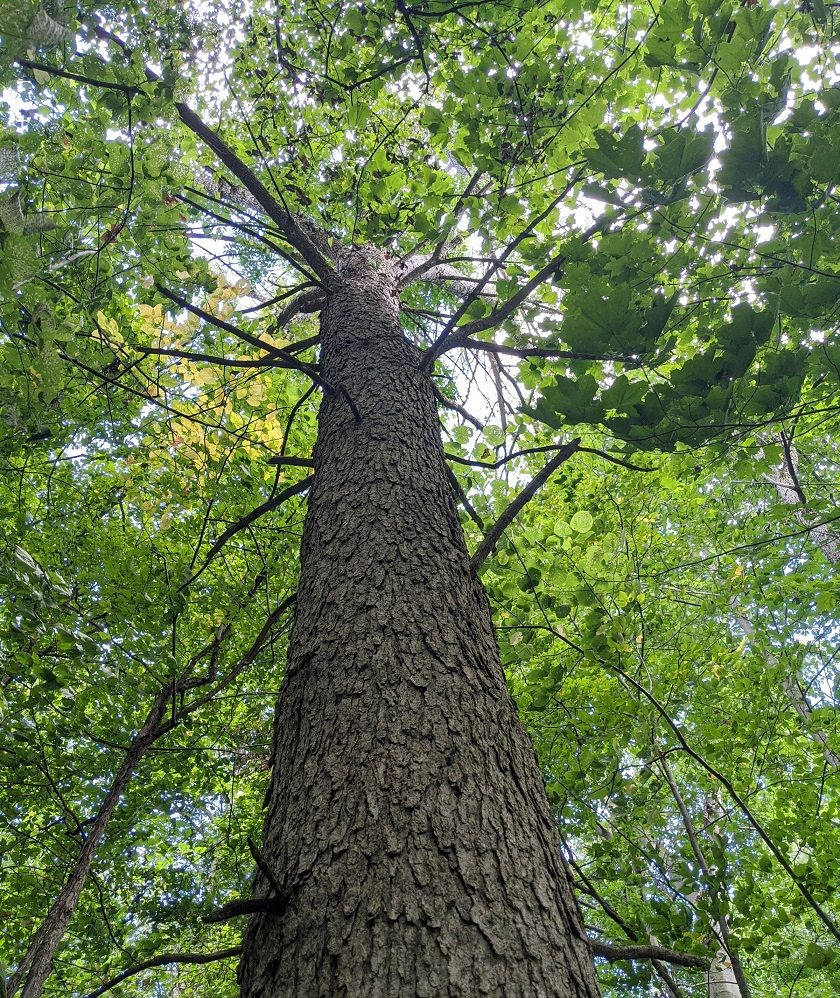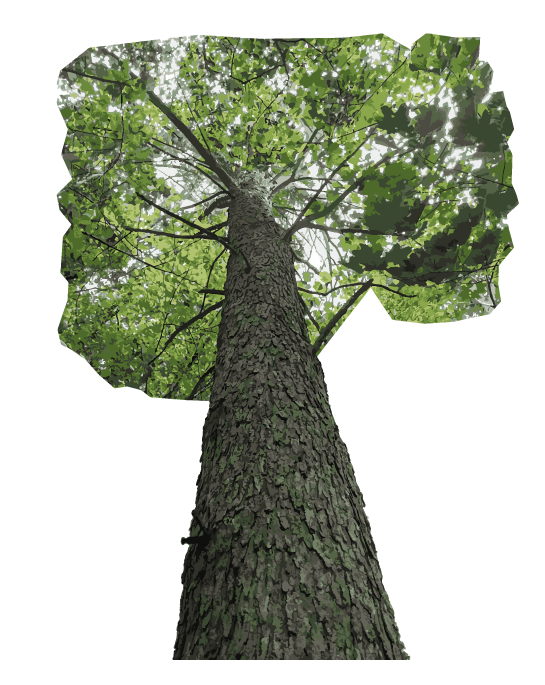Blue Ash

Species information
The following is a report on progress made towards the protection and recovery of Blue Ash (Fraxinus quadrangulata) in Ontario from 2007 to 2022, based on Ontario’s species-specific recovery policy. This report meets the legislative requirement for a review of progress under the Endangered Species Act, 2007 (ESA or “the Act”). Blue Ash is listed as threatened on the Species at Risk in Ontario (SARO) List under the ESA.
Blue Ash was classified as a species at risk under the previous Endangered Species Act. It was originally listed as a special concern species and was listed as such under the ESA when the Act came into force in June 2008.
The species was re-classified as a threatened species on June 15, 2016.
Blue Ash has been protected from being killed, harmed, harassed, captured or taken since 2016.
In addition, the habitat of Blue Ash has been protected from being damaged or destroyed since 2016.
The species-specific recovery policy for Blue Ash, known as the Government Response Statement (GRS) was published in 2018 and includes the government’s recovery goal for the species and the actions and priorities it intends to lead or support to help achieve that goal. The GRS considers science advice provided in the recovery strategy (published in 2017), such as species biology, habitat needs, threats to survival, knowledge gaps and approaches to recovery, when developing recovery actions for the species. As legislated in the Act, the purpose of this review is to report on progress made towards implementing the protection and recovery actions in the GRS. The review can also help identify opportunities to adjust and adapt the implementation of protection and recovery actions to achieve the recovery goal for the species.
Further information about Blue Ash, including the threats that it faces, and actions being taken to help protect and recover this species is available on the Government of Ontario webpage for Blue Ash. A summary on the progress towards the protection and recovery of Blue Ash and an annual update on the broader species at risk program (i.e. the Introduction to the 2023 Review of Progress report) is available on the Review of Progress towards the Protection and Recovery of Ontario’s Species at Risk webpage.
Snapshot: Progress towards the protection and recovery of Blue Ash
Progress towards meeting the recovery goal
- The recovery goal in the Government Response Statement (GRS) for Blue Ash in Ontario is “to maintain the distribution of the species and support increases in population abundance. The government supports investigating the necessity and feasibility of augmenting existing populations.”
- Progress has been made towards implementing the majority of the government-led actions and government-supported recovery objectives. Examples of progress include:
- Conducting research into the habitat conditions of Blue Ash to inform presence surveys at historical population locations and locations where Blue Ash is predicted to occur
- Continued surveys and research related to the Emerald Ash Borer (Agrilus planipennis Farmaire) (EAB) that threatens Blue Ash to better understand the presence and extent of impact from EAB and to provide insight into the degree to which the species is resistant to EAB
- In alignment with the GRS, it is recommended that additional efforts be made to collaborate with federal partners on implementing protection and recovery actions for Blue Ash, including those related to the genetic conservation, and to conduct research on the biology and ecology of Blue Ash including studying seed dispersal mechanisms and distances, as well as the potential effects of climate change on the species.
Occurrences and distribution:
- Fifty-six populations of Blue Ash have been documented in Southwestern Ontario. Currently, 32 of these populations are extant, whereas the remaining 24 are considered historical.
- Since 2008, the status of 20 populations changed from extant to historical based on the date that it was last observed, while no populations changed from historical to extant as their existence was confirmed through monitoring efforts.
- Nine populations of Blue Ash have been newly identified since 2008.
Government-supported stewardship projects:
- Through the Species at Risk Stewardship Program, the Government of Ontario has enabled its stewardship partners to conduct nine projects (by providing $551,447 in funding) designed to contribute to the protection and recovery of multiple species at risk, including Blue Ash. Eight of these projects were designed to provide benefits to multiple species at risk (e.g., landscape-level habitat restoration, or outreach and education focusing on a certain group of species such as those present in a local region), while one project focused exclusively on Blue Ash.
- The government’s support helped its stewardship partners to involve 115 individuals who volunteered 6,045 hours of their time towards protection and recovery activities for species at risk, including Blue Ash. The estimated value of these voluntary contributions, as well as additional funding and in-kind support, is $955,716.
- Stewardship partners reported that through their actions 162.2 hectares of habitat were enhanced for Blue Ash and other species at risk that inhabit the same ecosystem or different ecosystems.
- Stewardship partners reported providing outreach on multiple species at risk, including Blue Ash, to 1,657 individuals.
Supporting human activities while ensuring appropriate support for species recovery:
- The Government of Ontario has issued one ‘overall benefit’ permit for this speciesunder clause 17(2)(c) of the ESA
- Twenty-nine activities have been registered for the species. The activities were registered under ‘drainage works’ (section 23.9) and ‘threats to human health and safety, not imminent’ (section 23.18) under Ontario Regulation 242/08 of the ESA
Reporting on the progress towards the protection and recovery of Blue Ash
Recovery Goal
The government’s goal for the recovery of Blue Ash is to maintain the distribution of the species and support increases in population abundance. The government supports investigating the necessity and feasibility of augmenting existing populations.
The implementation of government-led and government-supported actions demonstrates progress towards reaching the desired objectives and the recovery goal set out in the GRS.
Progress towards implementing government-led actions
Progress has been made towards implementing the majority of government-led actions identified in the GRS. Common actions for the government to lead as it works towards achieving a species’ recovery goal include:
- Continue to implement the Ontario Invasive Species Strategic Plan (2012) to address the invasive species (e.g., Emerald Ash Borer) that threaten Blue Ash.
- Educate other agencies and authorities involved in planning and environmental assessment processes on the protection requirements under the ESA.
- Encourage the submission of Blue Ash data to Ontario’s central repository through the citizen science projects that they receive data from (e.g., iNaturalist) and directly through the Natural Heritage Information Centre.
- Undertake communications and outreach to increase public awareness of species at risk in Ontario.
- Continue to protect Blue Ash and its habitat through the ESA.
- Support conservation, agency, municipal and industry partners, and Indigenous communities and organizations to undertake activities to protect and recover Blue Ash. Support will be provided where appropriate through funding, agreements, permits (including conditions) and/or advisory services.
- Encourage collaboration, and establish and communicate annual priority actions for government support in order to reduce duplication of efforts.
Additionally, the government has directly undertaken the following species-specific actions:
- Continue to manage habitat in protected areas (e.g., Fish Point Provincial Nature Reserve) to maintain or improve suitability for the species using appropriate methods (e.g., construction of fenced enclosures to prevent herbivory) and continue to monitor ash trees in response of Emerald Ash Borer (e.g., in Komoka Provincial Park in London).
- Collaborate with federal partners, such as Environment and Climate Change Canada, Parks Canada and the Canadian Forest Service in implementing protection and recovery actions for Blue Ash, including those related to the genetic conservation of native ash trees, and investigating the impact of Emerald Ash Borer on native ash trees, including Blue Ash.
- For populations that occur on Pelee Island, explore opportunities to work collaboratively with the Township of Pelee, including the Pelee Island Environmental Advisory Committee, the federal government and local partners to integrate approaches to stewardship, implement recovery actions and explore integrated approaches to managing species at risk.
As a preliminary step to collaborating with federal partners on implementing protection and recovery actions for Blue Ash, including those related to the genetic conservation of the species, the Government of Ontario is establishing the Ontario Tree Seed Genetic Archive (OTSGA) at the Ontario Forest Research Institute (OFRI) in Sault Ste Marie. The primary goals of the OTSGA are to conserve the genetic diversity of forest tree species in Ontario and to develop science-based protocols for seed collecting, processing, testing, and long-term storage of targeted species.
Efforts to date have largely focused on Black Ash, however opportunities for conservation of other threatened ash species through OTSGA collections are possible moving forward. While not occurring at this time, OFRI and OTSGA have extensive experience in forest tree breeding, which may be valuable in establishing genetic improvement programs to breed potential Emerald Ash Borer resistance into ash tree populations in Ontario.
Ontario Parks monitors, protects, and manages habitat for Blue Ash in protected areas in the species’ range, including on Pelee Island (e.g., Fish Point Provincial Nature Reserve and Lighthouse Point Provincial Park) and the mainland (e.g., Komoka Provincial Park and Clear Creek Provincial Park). These management activities include invasive species management, habitat management, managing recreational pressures, and supporting research and partnership efforts. Ontario Parks also supports ongoing inventory and monitoring of species at risk, including Blue Ash, through research and inventory activities, and by facilitating activities of other organizations and individuals, including projects funded through the Species at Risk Stewardship Program.
Key progress made towards implementing the remaining government-led actions is described in the following sections.
Ontario’s Invasive Species Strategic Plan
The GRS for Blue Ash indicates that invasive species (e.g., Emerald Ash Borer (Agrilus planipennis)) pose a threat to the survival and recovery of the species in Ontario. The Ontario Invasive Species Strategic Plan, 2012 establishes a policy framework to prevent new invaders from arriving and surviving in Ontario, to slow and where possible reverse the spread of existing invasive species, and to reduce the harmful impacts of existing invasive species, including impacts on species at risk.
This framework may support the implementation of actions to reduce the threats from invasive species. For example, through the forest health monitoring program the government continues to monitor the invasive Emerald Ash Borer, which poses a potential threat to Blue Ash. Additionally, the government has collaborated with the Canadian Food Inspection Agency, who regulates Emerald Ash Borer, to develop management zones to slow its spread, and the movement of ash trees, logs, wood, and firewood of all tree species out of regulated areas is restricted.
Guides and resources
To help reduce the impact of threats of Emerald Ash Borer on ash trees in Ontario, the Government of Ontario has developed Preparing for Emerald Ash Borer: A Landowner’s Guide to Managing Ash Forests (2012). Management strategies for Emerald Ash Borer and landscape trees have also been developed by the Ministry of Natural Resources and Forestry.
Occurrences and distribution
Fifty-six populations of Blue Ash have been documented in Southwestern Ontario. Thirty-two are considered to be extant (i.e., observed within the past 20 years), 24 are considered historical
Since 2008, the government’s central repository at the Natural Heritage Information Centre (NHIC) has received 544 records of the species. These records are based on observations between 1954 and 2022 and come from a variety of sources. Records submitted have helped to refine where the species is known and has been known to occur and can provide additional information on the species’ habitat and threats.
Nine new populations have been observed since 2008 when the species was listed under the ESA. The newly identified populations are likely the result of increased search effort and education about Blue Ash and may not represent actual population increases, but rather increased knowledge about the distribution and abundance of the species.
It is possible that there are observations of Blue Ash that have not been submitted to the government. Encouraging the submission of observations of this species is included in the GRS as a government-led action. Submission of species observations increases our knowledge of where they occur and can play an important role in assessing the viability of species populations.
Everyone is encouraged, or may be required by an authorization or approval to submit observations of Blue Ash, and any other species at risk observed, to the NHIC for incorporation into the provincial record of observations.
-
554observations of this species were submitted to the NHIC since 2008.
Government-supported stewardship projects
An important government-led action in the GRS for Blue Ash is to support partners to undertake activities to protect and recover the species. Through the Species at Risk Stewardship Program the government has supported a total of nine projects ($551,447) designed to contribute to the protection and recovery of multiple species at risk, including Blue Ash. Eight of these projects were designed to provide benefits to multiple species at risk (e.g., landscape-level habitat restoration, or outreach and education focusing on a certain group of species such as those present in a local region), while one project focused exclusively on Blue Ash. In addition to the government funding, these partners reported they were successful in securing additional funding ($955,716) from other sources, including in-kind support in the form of time and expertise provided by volunteers.
As well, 115 individuals volunteered 6,045 hours of their time towards protection and recovery activities for multiple species at risk, including Blue Ash, which has an estimated value of $195,655. Partners also reported that through both their efforts and the efforts of their volunteers to implement GRS actions, they were successful in enhancing 162.2 hectares of habitat that will benefit Blue Ash or other species at risk. Ecosystem-based outreach on multiple species, including Blue Ash, that was undertaken by stewardship partners reached 1,657 individuals.
The remainder of this section highlights two projects supported through the Species at Risk Stewardship Program as well as the corresponding government-supported recovery actions for the species.
To support the high priority GRS action to develop population viability models for Blue Ash in Ontario, Natural Resources Solutions Inc. worked with various agencies and stakeholders to develop a standardized long-term health monitoring program. This included the development of a detailed monitoring protocol and the collection of baseline data to quantify the current condition of Blue Ash populations in Ontario. The collected monitoring data, including the assessment of Emerald Ash Borer presence, can be used to inform modeling of population dynamics at surveyed sites if the protocol continues to be implemented. Given that there is a lag time of approximately five years between early Emerald Ash Borer infestation and when symptoms become apparent in Blue Ash, this monitoring data may also provide insight into the degree to which local populations or individuals are resistant to Emerald Ash Borer if symptoms take longer to appear than expected. This is an important first step towards positioning land managers to be able to detect changes in the health of Blue Ash populations.
Additionally, this project supported the high priority GRS action to investigate the effectiveness of potential measures to mitigate impacts of Emerald Ash Borer on Blue Ash by conducting tree health assessments that included both trees that had and had not been treated with the insecticide TreeAzin in the past. This assessment established that TreeAzin was likely effective in protecting Blue Ash at these sites from Emerald Ash Borer, while underscoring that the product is only effective for several years and requires re-application. The addition of this tree health monitoring data of both treated and untreated Blue Ash trees will provide insight into the most effective methods to mitigate the impacts of Emerald Ash Borer in Ontario.
The same project supported the high priority GRS action to collaborate with relevant partners to conserve the genetic diversity of Blue Ash and to support research and recovery of the species. During their surveys, Natural Resources Solutions Inc. worked with Point Pelee National Park staff to collect a sufficient amount of Blue Ash seed and leaf tissue to send to the National Tree Seed Centre for testing and archiving for possible future recovery efforts.
Another stewardship partner, the Geomatics and Landscape Ecology Research Laboratory at Carleton University supported the high priority GRS Action to conduct research into habitat conditions of Blue Ash to inform presence surveys where they are predicted to occur. The partner tested a new way to optimize survey efforts for 38 species at risk in Southern Ontario, including Blue Ash. They refined and verified species distribution models and designed an algorithm that ranked various areas for surveys. At least 12 areas were predicted to have suitable habitat for Blue Ash in this project.
-
 8
8projects including Blue Ash
-
 1
1project for Blue Ash exclusively
-
 $551,447
$551,447for projects that included Blue Ash
-
 $955,716
$955,716in additional funding and in-kind support
-
 115
115volunteers
-
 6,045
6,045volunteer hours
-
 1,657
1,657people received outreach
-
 162
162hectares of habitat enhanced
Supporting human activities while ensuring appropriate support for species recovery
Supporting partners through authorizations and their associated conditions is an important government-led action.
In total, one ‘overall benefit’ (17(2)(c)) permit was issued exclusively for Blue Ash since the species has been protected under the ESA. Several of the conditions included in the permits are designed to implement government-supported actions identified in the GRS for Blue Ash including:
- Maintain recently planted Blue Ash trees over several years in a nearby conservation area by applying best management practice including erecting exclusion fencing to deter browsing by deer and to restrict recreational activities
- Monitoring and reporting of both newly planted Blue Ash trees and a mature Blue Ash stand to identify any correlation between growth rates and site conditions.
- Monitor for evidence of Emerald Ash Borer infestation in the mature stand by comparing results to the infestation rate of other existing mature ash species
Other conditions designed to minimize adverse effects include:
- Clearly mark retained trees and corresponding critical root zone to ensure awareness by on-site personnel
- Re-route construction and development activities around retained trees to avoid impacts to the individual and habitat
More detailed information regarding ‘overall benefit’ permits for this species is available through the Environmental Registry of Ontario.
Registration information
Twenty-nine activities that may affect Blue Ash or its habitat have been registered for the purposes of Ontario Regulation 242/08: ‘General’under the ESA. Twenty-three activities were registered under ‘threats to human health and safety, not imminent’ (section 23.18) and six activities we registered under ‘drainage works’ (section 23.9). These registrations require the registrant to comply with all conditions of the regulation, such as:
- preparing a mitigation plan using the best available information on steps that may help minimize or avoid adverse effects on the species
- installing and maintaining barriers or other structures to create a protective zone around the species; and
- ensuring that reasonable steps are taken to minimize adverse effects of the activity on the species and its habitat
-
1overall benefit permits
-
29registrations
Progress towards implementing government-supported actions
Government-supported actions are organized under overarching recovery objectives. Progress has been made towards achieving the majority of the government-supported recovery objectives and implementing several of the associated actions identified in the GRS for Blue Ash.
Objective: Increase knowledge of Blue Ash distribution, abundance, habitat, condition, and the significance of threats in Ontario.
- Action No. 1 (High Priority) - Conduct research into the detectability and habitat conditions of Blue Ash and use to inform presence/absence surveys at historical population locations and locations where Blue Ash is predicted to occur.
- Action No. 2 (High Priority) - Develop population viability models for Blue Ash in Ontario and implement a standardized long-term monitoring program in collaboration with landowners, land managers (including conservation authorities), researchers, municipalities, and interested Indigenous communities and organizations. Use this information to assess and monitor the status of populations and increase understanding of how population viability is affected by multiple threats and limitations.
- Action No. 3 (High Priority) - Investigate the effectiveness of potential measures to mitigate impacts of EAB on Blue Ash.
Under this objective, initial progress has been made towards implementing Action No.1, Action No. 2 and Action No. 3.
Research projects supported by the Species at Risk Stewardship Program demonstrated progress towards Action No. 1 through the development of species distribution models. One project used a spatial prioritization algorithm to predict areas with suitable habitat for species at risk, including Blue Ash. Results from these models can be used to focus survey efforts on sites that were most likely to have Blue Ash present.
Progress was made towards Action No. 2 through conditions of an ESA authorization and projects supported by the Species at Risk Stewardship Program. Conditions included the initiation of long-term monitoring of differently aged Blue Ash stands, site characteristics and conditions to better understand what habitat characteristics and conditions limit the success of Blue Ash.
Progress has also been made towards Action No. 3 through projects supported by the Species at Risk Stewardship Program that analyzed the effectiveness of inoculating trees with the insecticides TreeAzin against Emerald Ash Borer.
Objective: Maintain or improve the quality of habitat and reduce threats to the species at locations where it exists in Ontario.
- Action No. 6 (High Priority) - Develop, implement and evaluate best management practices in collaboration with landowners, land managers, municipalities, the research community and interested Indigenous communities and organizations to improve habitat suitability, minimize threats to Blue Ash and its habitat, and preserve genetic material.
Under this objective, initial progress has been made towards implementing Action No. 6.
Action No. 6 has been implemented through projects supported by the Species at Risk Stewardship Program and through conditions of an ESA authorization. Progress on this action includes the collection of Blue Ash seed and leaf tissue for genetic archiving that may support research and recovery efforts.
Objective: Increase local awareness of the species and ways to minimize threats to Blue Ash.
- Action No. 9 - Promote awareness about Blue Ash among local landowners, land managers and interested Indigenous communities and organizations and promote community involvement by sharing information on Blue Ash.
Under this objective, progress has been made towards implementing Action No. 9 through projects supported by the Species at Risk Stewardship Program. Relevant projects have included the creation and distribution of outreach materials to members of the public and private landowners in areas where Blue Ash occur.
Summary of progress towards meeting the recovery goal
The recovery goal for Blue Ash is “to maintain the distribution of the species and support increases in population abundance. The government supports investigating the necessity and feasibility of augmenting existing populations.” Effort made towards the government-led and government-supported actions has helped to make progress towards this goal. For example, stewardship projects were completed that included the development of standardized survey and monitoring protocols. These were used in tandem with distribution models and predictive maps to increase the effectiveness of search efforts for Blue Ash in Southwestern Ontario.
In addition to the inventory and survey work, stewardship projects and permit conditions have contributed to a clearer understanding of population dynamics by collecting data on environmental factors and analyzing their relationship with Blue Ash. These include soil characteristics, rain events, understory population and growth, and invasive species including invasive ground cover and the Emerald Ash Borer.
Additionally, projects investigating the actions that can be taken to reduce threats to Blue Ash by Emerald Ash Borer have taken place. Tree health assessments of both insecticide-treated and untreated Blue Ash trees contribute to a growing body of knowledge on the most effective measures to mitigate the impacts of Emerald Ash Borer. Projects like these will aid in continued and future efforts to maintain the distribution and increase the population abundance of Blue Ash.
Recommendations
As stated in the GRS, this review of progress can be used to help identify whether adjustments to the implementation of GRS actions are needed, to achieve the protection and recovery of the species. Based on progress to date, the overall direction provided in the GRS for Blue Ash, particularly the implementation of actions identified as high priority, should continue to guide protection and recovery of the species.
Although initial progress has been made towards the government-led action to collaborate with federal partners on implementing protection and recovery actions for Blue Ash, including those related to genetic conservation, further work is required to fully implement this action.
While there has been much focus on the progression of other actions, the following actions require additional support to aid the protection and recovery of the species:
- Government-led action - Explore taking appropriate management actions in accordance with provincial policy direction on cormorants to support protection and recovery for Blue Ash
- Action No. 4 - Conduct research on the biology and ecology of Blue Ash including studying seed dispersal mechanisms and distances, as well as the potential effects of climate change on the species.
- Action No. 5 - Investigate the feasibility and necessity of augmenting Blue Ash.
Protecting and recovering Blue Ash will continue to be a shared responsibility that will require the involvement of many individuals, organizations and communities. Financial support for the implementation of actions may be available through the Species at Risk Stewardship Program. The government can also advise if any authorizations under the ESA or other legislation may be required to undertake a project. By working together, progress can continue to be made towards protecting and recovering Blue Ash in Ontario.
Footnotes
- footnote[1] Back to paragraph A population is considered historical if it has not been recorded within the last 20 years. Historical populations may still exist, but updated information is not available.